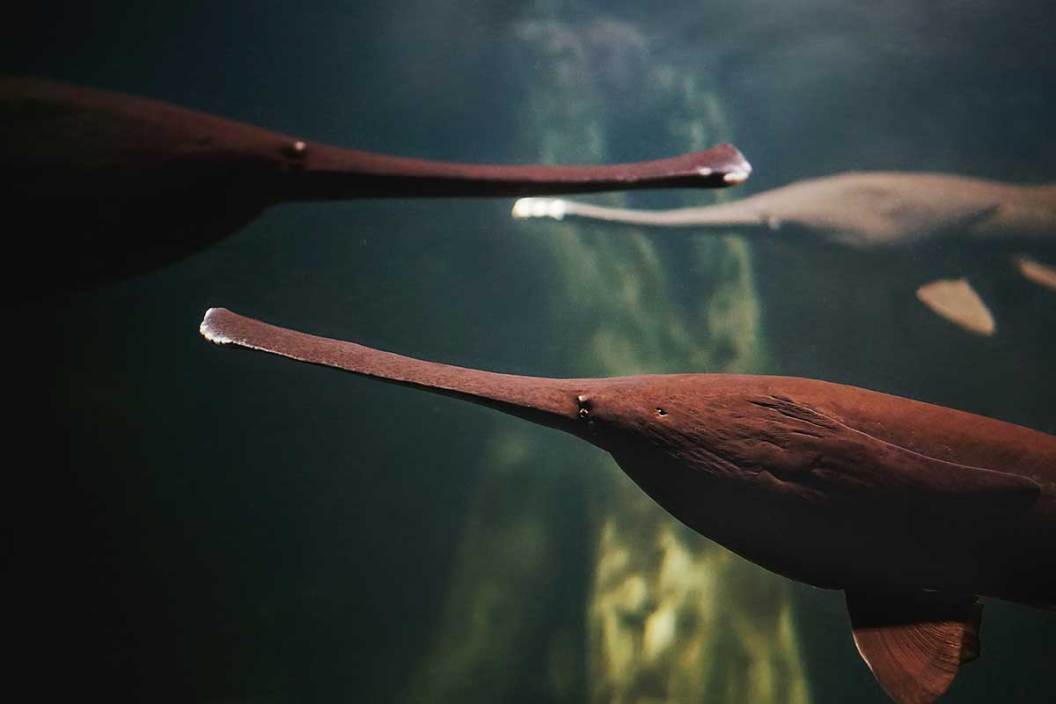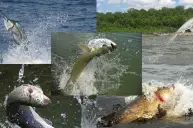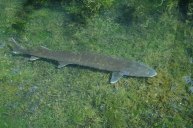The American paddlefish is a native and ancient fish still living in North America's waters.
The American paddlefish is an oddity, plain and simple. If you've never seen one before, you may mistake it for something that lives deep in the jungles of the Amazon.
The fact is that this ancient fish has inhabited North America for millions of years, and we're only just starting to get to know it.
Maybe one of the most fun questions we ask is: can you go fishing for one? And the answer is yes, but with some obvious restrictions. For the most part, they're only allowed to be caught by snagging.
Since paddlefish are filter feeders—eating mostly plankton plus the occasional insect or small fish—the only real way to hook up with one is to rig up a heavy duty rod and reel system spooled with some heavy weight braided line and cast a weighted treble hook into the depths.
While many folks say that eating the flesh of one of these prehistoric fishes is great, many more prefer them for their caviar. It's a great reward, but also one of the biggest reasons why American paddlefish have become an endangered species in certain areas of their overall range. Their official classification listings go from endangered to threatened to species of concern in several states, according to the U.S. Fish and Wildlife Service.
Let's take a closer look at the American paddlefish, also known as the spoonbill, and see why so many anglers and conservationists care about them.
American Paddlefish Profiled
The paddlefish is a prehistoric species that has been living in North American waters, specifically the Mississippi River basin, since the Cretaceous period, some 65 million years ago. The Polyodon spathula, the paddlefish's scientific name, has only one other relative on Earth, the Chinese paddlefish (Psephurus gladius) from Asia. Both species have be known to grow to well over 100 pounds and up to six feet in length.
Paddlefish have no scales to speak of and some folks even regard their skin as tough and shark-like in its appearance and texture. Their most unique feature is the obvious paddle-shaped rostrum, or snout, which is covered with tens of thousands of sensory receptors used for locating swarms of zooplankton and larvae that they eat while using their gill rakers to filter it all out.
The paddlefish loves the deeper waters of the Mississippi River system and its tributaries, especially the slower moving freshwater rivers. The USFWS says that it is a migratory species and some individuals have been known to move more than 2,000 miles within the same river system. They can swim through brackish water as well, further increasing the possible places they may be found.
Female paddlefish don't spawn until they reach seven to 10 years of age, and only do it once every two or three years.
American paddlefish were once the most important commercial species in the Mississippi River Valley, and by the early part of the twentieth century, their numbers began to decline due to overfishing. More recently, the Beluga sturgeon population decrease in Eastern Europe has led to the illegal poaching of paddle?sh. Both species have coveted eggs, and the high prices that can be generated by selling paddlefish roe is tied to the increase of illegal harvesting. These circumstances have resulted in their protection not only by U.S. law, but by the CITES Act, or the Convention on International Trade in Endangered Species.
Conservation and restoration programs now include marked study and monitoring along with hatchery rearing of eggs and stocking efforts in their historical range. If this spectacular fish is to survive another 65 million years, it will need humans to further encourage their protection and restoration.
Fishing for Paddlefish
As mentioned, paddle?sh feed on zooplankton, microscopic plants and animals found in water bodies. If you plan on fishing for them, you're going to have to leave your worms, cut bait, and lures at home.
There are approximately 22 states in the U.S. where the paddlefish can be found, and all are protected under state and federal laws. There are around 13 states that still allow commercial or sport fishing for the American paddlefish including Arkansas, Illinois, Iowa, Kansas, Kentucky, Mississippi, Missouri, Montana, Nebraska, North Dakota, Oklahoma, South Dakota, and Tennessee.
The rigor of pursuing big paddlefish often includes a lot of effort: navigating the large rivers, yanking heavy lead weights with large, barbed treble hooks through the water, using a broom handle rod (short, stiff, and sturdy) to wrestle them from the depths, and spending long hours trying to snag one of these monsters. Together, the requirements call for a style of fishing typically left to the most fit and dedicated anglers.
But in no way should that stop you from trying! A fishing guide is an easy way to get an introduction without committing to the gear and the search. In fact, some guides will set up and troll for these brutes using electronics to find and target them, while adding in their vast experience to keep out of snags and underwater hazards. For anglers that want more of a hands-on experience, casting is still an option for anyone who doesn't mind some sore muscles at the end of the day.
Paddlefish: Past, Present, and Future
Paddlefish have remained unchanged for almost 300 million years, before the dinosaurs roamed Earth. In Montana, for instance, people thought that the paddlefish was extinct until one was accidentally snagged way back in 1962. That discovery caused scientists to try and restore the native fish into the Yellowstone River system, which is still an on-going effort.
View this post on Instagram
As freshwater fishes go, the spoonbill is one of the most unique and widely studied animals in North America. Overfishing in the beginning of the century almost caused them to disappear, but with aquaculture understanding and other fisheries system advancements, they have become a popular and widely sought after sport fish for anglers in certain parts of their range.
Some adult paddlefish are the unfortunate targets of poaching and illegal fishing in places where they still exist in the United States. But paddlefish populations are now a great concern of esteemed organizations such as the American Fisheries Society, giving this great and ancient fish the chance it deserves.
Looking for a little more or even hot lunch for your hunting blind? Follow my webpage, or on Facebook and YouTube.
NEXT: FISHING FOR FLATHEAD CATFISH: TECHNIQUE, LOCATIONS, GEAR, AND MORE
WATCH




